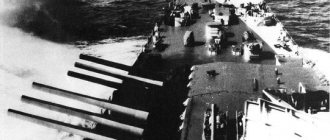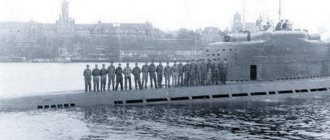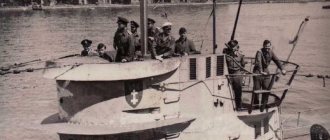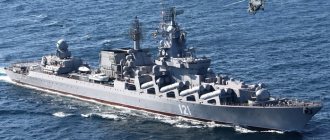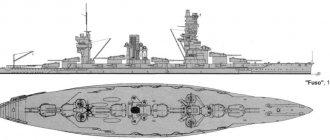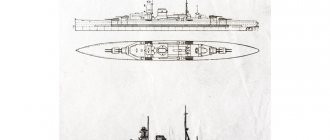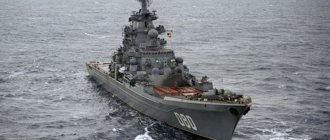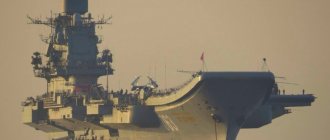Alexander Soloviev Heritage June 27, 2018
Among the miniature exhibits of the Central Naval Museum is a model of the German cruiser Emden from the First World War, placed in a bottle. Moreover, a whole plot is built inside it: there is even smoke coming from the chimneys of the ship...
Photo: Dmitry Sokolov
The Emden, laid down in 1906 at the naval shipyard in Danzig (now Gdansk, Poland), became famous for its successful actions against merchant shipping and warships of the Entente countries in the Indian Ocean. From August 1 to November 9, 1914, Emden captured 23 merchant ships, and also sank the Russian cruiser Zhemchug and a French destroyer.
It is always surprising to ignorant people how you can put a ship in a bottle. For specialists, everything is clear. The body, previously disassembled into parts, is assembled with special tools already inside the bottle, and a hinge is hidden at the base of the masts or pipes, allowing them to be tilted and folded.
Researchers call "Emden" a "noble raider" or a "magnanimous corsair." The captain of the cruiser von Müller had a reputation as a true gentleman in war. The fact is that he strictly observed the laws and customs of military operations at sea and treated prisoners humanely. As a result of the cruiser's actions, not a single person from the crews or passengers of the captured merchant ships was killed.
However, sooner or later, luck had to turn away from the invulnerable raider. In the battle of the Cocos Islands, he was defeated by the Australian cruiser Sydney. True, everything was very noble here too.
When the outcome of the battle was already clear, the Emden commander received a message: “In the name of humanity, I have the honor to demand the surrender of your ship. Paying tribute to your valor, I am forced to state the following: 1. Your ship is on the rocks. Three chimneys and a mast were knocked down. Most of the guns are disabled. 2. You are unable to leave this place. On the other hand, the ship entrusted to me is safe and sound. Therefore, from my point of view, surrender is not a dishonor for you, but simply the result of unfavorable circumstances.”
The team of the German cruiser agreed. The Emden itself stood on the rocks until the mid-1950s, when it became the prey of a Japanese shipbuilding company... One of its guns is installed in Hyde Park in Sydney.
The material was published in the newspaper No. 113 (6222) dated June 27, 2018 under the heading “Noble Raider.”
#Naval Museum #history #cruiser
The material was published in the newspaper “St. Petersburg Vedomosti” No. 113 (6222) dated June 27, 2018.
Share on VKontakte Facebook
Cool
Booking
The basis of the reservation was a proprietary German armored belt with a thickness of 50 mm, which had a length of about 125 m and a height of 2.9 m, falling 1.3 m below the design waterline. The armored belt covered more than 80% of the body. The armored belt was closed by a 40 mm thick traverse.
Armored deck. It was made up of 20-mm armor plates, and above the artillery magazines the number of plates was doubled, resulting in a thickness of 40 mm.
The steering gear in the stern was covered by an armored box 20 mm thick.
Conning tower. Traditionally good for all German ships: 100 mm walls, 20 mm roof and floor. A 20-mm communication pipe ran from it to the central post located under the armored deck.
The shell supply shafts also had a thickness of 20 mm. And lastly, the gun shields were made of the same 20 mm armor plates. In general, not many ships could boast of such armor. For a light cruiser it was all quite impressive.
The crew number is 582 people, including 26 officers and 556 sailors.
Seaworthiness. It's not easy here. The Germans, naturally, praised their ship. The British criticized mainly for the low, “creeping” silhouettes. However, if you look at the number of miles that the Emden traveled during its service, it becomes clear that the ship was quite successful.
Section materials
January 23, 08:00
22 security officers were awarded the Order of Lenin, posthumously. Night battle near the village of Khludnevo
January 21, 13:06
Animal trade. Why did they steal dogs in St. Petersburg in the 19th century?
January 21, 13:03
"Golden Voice" How Elizaveta Petrenko helped Stravinsky’s talent to reveal itself
January 21, 12:52
Palace in a bend of the river. How the LDM was built
January 21, 12:47
On the ice of the Neva. How they managed without bridges in winter St. Petersburg in the 19th century
Armament
Main caliber: eight 150 mm guns in single-gun turrets. The guns were located in the same way as on the cruisers of the Kaiser's fleet. Two guns (No. 2 elevated above No. 1) in the bow, two in the stern (one on the poop, one on the stern superstructure), two guns on the sides of the bow superstructure directed towards the bow and two guns near the second funnel directed towards the stern .
Thus, the maximum number of guns that could participate in the salvo was six.
Attempts to improve weapons by installing twin gun mounts were made until the start of the war, which, in fact, put an end to all plans. The most interesting modernization project of 1940 may have been the installation of four twin-gun turrets, which were developed for the Narvik-class destroyers. And the anti-aircraft weapons will be strengthened with one 88-mm gun and two 37-mm machine guns. And leave a couple of onboard guns for firing illumination shells.
However, the outbreak of the war put an end to modernization and until its end the Emden served with single-gun installations.
Anti-aircraft armament consisted of three 88-mm Flak L/45 anti-aircraft guns of the 1913 model.
The guns had a good rate of fire (up to 15 rounds per minute), a height reach of 9,150 m and a firing range of 14,100 m. The initial projectile speed was 790 m/s. The ammunition load consisted of 1200 shells.
The anti-aircraft guns were located on the superstructure behind the chimneys.
The mine-torpedo armament consisted of two double-tube 500-mm torpedo tubes with an ammunition load of 12 torpedoes. In 1934, the devices were replaced with 533 mm.
The cruiser could take on board 120 minutes.
Modernization. In general, the Emden became the most modernized Kriegsmarine ship in its entire short history. The upgrades ranged from purely cosmetic to significant.
In 1933-1934, 4 coal boilers were replaced with oil ones. At the same time, the 500 mm torpedo tubes were replaced with 533 mm ones.
In 1937, anti-aircraft weapons were strengthened with 6 20-mm machine guns and two 37-mm machine guns.
In 1940, two quadruple 20-mm machine guns appeared in experimental installations - prototypes of the famous “vierling”. They were installed side by side on the deck of the superstructure in the area of the mainmast. At the same time, the MES demagnetization device was installed.
In 1941, when transferred to a training ship, all machine guns were removed from the Emden, except four single-barreled 20-mm ones. But the training ship did not require such protection.
At the end of 1942, all main caliber guns were replaced with new ones and two 20-mm Vierlings were reinstalled. FuMO 21 radar installed.
At the beginning of 1943, two more “fierlings” and two 20-mm single-barreled machine guns were installed.
In August 1944, instead of 88 mm guns, three 105 mm universal guns, two 40 mm Bofors machine guns, and 20 20 mm machine guns (2 x 4 and 6 x 2) were installed.
New in blogs
KRL Emden model.
Von Mücke's book about his cruiser.
The light cruiser Emden was laid down on November 1, 1906 at the Naval Shipyard in Danzig. The ship was built according to the 1905-06 Program for strengthening the Kaiser's fleet, which was only gaining strength.
Due to financial problems, the construction of the cruiser proceeded very slowly and for the first year and a half of the slipway period there was virtually no construction.
Only on May 26, 1908, the Emden was launched from the slipway. The burgomaster of the city of Emden, Privy Councilor Dr. Furbringer, acted as the “godfather” who gave the ship its name and broke a bottle of Rhine wine on its stem.
By the summer of 1909, Emden was completed. It was a light cruiser, typical of German shipbuilding at that time, with a displacement of 4268 tons, a length of 118.3 meters, armed with ten 105 mm and eight 52 mm guns, as well as two torpedo tubes. A three-cylinder triple expansion steam engine, powered by coal, provided the new cruiser with a speed of 23.5 knots.
Before the start of WWI, the cruiser sailed a lot and for a long time on the seas and oceans. He took part in suppressing uprisings in China. In general, I went around half the world.
After a long stay in South Chinese waters, the Emden returned to Qingdao in May 1914...
On July 27, the Admiralty in Berlin notified Qingdao that Austria had broken off diplomatic relations with Serbia.
On July 28, a message was received announcing a state of war between the Austro-Hungarian Empire and the Serbian Kingdom.
On July 28, the Emden radio room received an order from the Main Naval Headquarters in Berlin: “Try to connect with the main forces of the squadron.”
On July 31, 1914, at 19:00, the Emden departed from the coal wall of Qingdao and in the evening twilight headed towards the exit to the sea. Following the cruiser was the coal miner Elsbeth. Soon both ships disappeared into the darkness.
On the night of August 3, the Emden entered the sea road between Vladivostok and Shanghai, continuing to move north to the historical Tsushima Strait. At night, the radio announced the beginning of war between Germany and France. However, this did not surprise anyone. The question that seemed much more important was: would Great Britain enter the war? Will the British be among his opponents? This worried Müller far more than the Russians and the French combined. Meanwhile, Qingdao reported that three Russian merchant ships were anchored in Nagasaki.
A raging oncoming storm and gushing rain forced Muller to change course and head towards the eastern entrance to the Tsushima Strait. Around 04:00, the famous island of Tsushima opened up ahead, and a few minutes later, in the first rays of dawn, a blurry silhouette of a large ship was discovered through the rain that continued to lash. Müller abruptly moved the engine telegraph all the way forward, and the Emden trembled as the machines switched to full combat mode. Some on the bridge mistook the unknown ship for the Russian cruiser Askold, but it soon became clear that it was not a warship, but a twin-tube merchant ship. In the gaps of fog and rain, for a moment its body, painted black, and two large yellow pipes became clearly visible.
The steamer "Ryazan" became the first prize of the German fleet captured on the high seas during the outbreak of the World War. Due to the fact that there were many women on the Ryazan, Muller decided to deliver his prize to Qingdao. In addition, the captured steamer was ideally suited to the role of an auxiliary cruiser, especially considering the speed that it demonstrated while escaping the pursuit. Its speed was at least 17 knots. The Ryazan set sail, and the Emden followed, keeping about 300 meters astern of the steamer.
The weather gradually improved, becoming warmer and calmer. The sea was bathed in the sun's rays. At approximately 17:00, the signalman in the crow's nest reported seeing smoke from the chimneys of at least five ships. There was no doubt that this was a French squadron: the armored cruisers Duplex and Montcalm with escort destroyers.
Müller immediately ordered a turn 8 degrees to the left in order to create three Emden funnels and avoid accurate identification by the enemy. The French squadron moved south in frontal formation. But absolutely nothing happened. The impression was that the French did not notice anything, although Lauterbach on the Ryazan ordered the boats to be prepared for launching, and the steamer itself to be scuttled.
In the evening, when the crew on the Emden was having dinner, the messenger brought Müller to the bridge an intercepted radiogram transmitted in clear text from the French cruiser Duplex to the small mail steamer Amazon, which said: “The German heavy cruisers Scharnhorst and Gneusenau are blockading Tsushima Strait. Return to Kobe immediately."
Now everything has become more or less clear. The French mistook the Emden for the Scharnhorst! It is understandable why they passed by without attempting to engage in battle. (Two armored cruisers were afraid of one supposedly Scharnhorst??? Doubtful. Most likely they just missed it)
On the morning of August 6, the Emden arrived in Qingdao and anchored in the same place from which it left on July 31.
Continuing to worry about the fate of the Marcomanni, Müller led the cruiser south to rendezvous with Admiral Spee's squadron. On August 12, around noon, one of the Mariana Islands, which belonged to Germany, sailed along the starboard side of the Emden, and right ahead, the extinct volcano of the island of Pagan, where Admiral Spee appointed a rendezvous for the Emden, rose from the horizon.
"Emden" went around the high rocky coast of the island, and a bay suddenly opened up in front of it with the cruisers of Admiral Count Spee standing in it.
It was an unforgettable sight! The Emden sailors, accustomed to acting alone, could not even believe that so many German ships had gathered here, at the very edge of the world.
The first to catch the eye was the light cruiser Nuremberg, which the crew of the Emden had not seen for many months while the Nuremberg was in Mexican waters, where it had only recently been replaced by the Leipzig.
Further, in the depths of the bay, the Scharnhorst and Gneisenau were anchored, surrounded by auxiliary ships. The Gneisenau was loading coal. A signal from the flagship Scharnhorst assigned Emden an anchor spot under the very rock that the cruiser had just rounded.
All night the Emden sailed as part of a squadron, and its crew wondered where they were going this time. Some believed that the squadron was heading towards Australia, others correctly believed that its path lay to the west coast of America, and then around Cape Horn into the Atlantic.
To their great surprise, at 07:00 the flags of the signal to Emden went up on the flagship: “Begin a separate voyage. I wish you complete success." Muller responded with a semaphore flag: “Thank you for your trust. Happy sailing and success." The Emden then raised the signal for the Marcomanni to follow. The steamer, which had more than 5,000 tons of precious Shanghai coal on board, approached the Emden, and a signal officer was transferred to the cruiser to ensure uninterrupted communications. And on the cruiser, the officers and sailors who knew nothing continued to wonder where they would now go, until the long-awaited order came: “Course southwest, speed 12 knots.” One glance at the map was enough to understand that the Emden was heading for the Indian Ocean.
In the morning, approaching the place of the planned rendezvous with the Offenbach coal miner, the Emden discovered a warship approaching the cruiser.
“Raise the topmast flags! - commanded Muller. - Prepare for battle!
Most likely, the unknown ship was supposed to be Dutch, but the Emden was ready for anything. The unknown ship also raised its topmast flags, which in all navies of the world meant readiness for battle.
The gunners of the Emden stood at the guns, awaiting the order to open fire. If it was an enemy ship, then the situation looked very serious: the Emden was “behind the coast” and, in order to leave the bay, was forced to approach under fire. The unknown ship was no more than 3,000 meters away when it was finally possible to make out its flag. This, as expected, was the Dutch coastal defense battleship Tromp, which had turret artillery with 9.4-inch guns. (234 mm???).
At dawn on September 4, the Emden entered the lagoon. The island was a solid green cap of impenetrable jungle, breathing malarial fumes. The Marcomannia followed, strictly keeping in the wake of the cruiser. To everyone's disappointment, the Ulm was not in the bay. Again we had to take coal from the Marcomanni. The next loading began at 9 am.
Near the shore, the huts of a native village are located on stilts. Frightened by the menacing appearance of the Emden, the natives did not appear from their huts for a long time. Finally, some of them, plucking up courage, approached the Emden with their pies, offering coconuts and oysters for sale. The doctor forbade the purchase of oysters, which looked too suspicious, but they bought a lot of coconuts. Or rather, they didn’t buy them, but exchanged them for empty bottles, which for some reason the natives really liked. The sailors opened the nuts with cleavers and drank the thick, sweet milk with pleasure.
In the evening, having received 450 tons of coal, loading was interrupted. People needed rest. Because of the heat and stuffiness, many could no longer sleep in the cabins and forecastles, preferring to lie down on the upper deck.
On September 9, at about 23:00, white lights were detected four degrees to the starboard bow. Finally! "Emden" rushed at full speed towards these lights, ordering the "Marcomannia" signal! follow him. The battle alarm bells blared on the Cruiser. The steamer carrying white lights could well have been escorted by warships. And in such cases, in order to escape, you always need to be the first to open fire. Although the night was dark, gradually the steamer carrying lights began to take shape. It was a single-tube merchant ship. Müller looked with displeasure at the Emden pipes. When moving at full speed, clouds of sparks rained down from them, unmasking the cruiser. This is how the vaunted Shanghai coal, which was called “smokeless” in advertising, behaved in the furnaces. The steamer, however, did not seem to notice at all that someone was chasing him. The Emden fired two warning shots, reminding the ship that there was also a war going on in the Indian Ocean. The searchlight transmitted the order to the ship: “Stop immediately! Turn off the radio station! Armed with rifles and revolvers, the prize crew quickly boarded the ship.
On the bridge of the Emden, they tensely awaited a message from Lieutenant Lauterbach, who for the first time since Ryazan had the opportunity to fulfill his duties. The minutes passed languidly. Finally, Lauterbach signaled: “Greek steamer Pontoporos.”
Muller clenched his teeth. Neutral again! A neutral who needs to be released so that tomorrow everyone will know that the Emden is in the Indian Ocean. But Lauterbach's message continued: “The cargo is 6,500 tons of Indian coal, intended for the British. The ship is traveling from Bombay to Calcutta."
This was a great lead since the coal was destined for the British. Mueller decided to seize the cargo as "military contraband." By order of the commander, Lauterbach offered the Greek captain a “German charter” with generous compensation. In other words, this meant that the Greek henceforth became the Emden coal miner.
Around 09:00 a large plume of smoke appeared over the northern horizon. Leaving behind the stern "Marcomannia" and "Pontoporos", "Emden" rushed at full speed in this direction.
. A stack of burning papers flew overboard from the ship's stern porthole. There was no doubt that the captain was destroying secret documents. The prize crew, led by Lieutenant von Levetzow, boarded the ship. It turned out that it was an English steamship with a displacement of 3413 tons called the Hindu, built in 1904.
The Hindu was owned by the James Nurse shipping company and operated on the line between Calcutta and Bombay. Currently, the ship was carrying out a charter from the Government of India to transport troops to Bombay and had already been converted into a troop transport. The strange white structures on the deck turned out to be stalls for horses.
Lieutenant Mücke, being the “housekeeper” of the Emden as the senior assistant commander, was most worried about soap, the supply of which had practically dried up, and washing on the cruiser had become a luxury. Now they found so much soap on the Hindu that the Emden was supplied for many months. The sailors of the cruiser searched the premises of the Indus, trying to determine what should be transported to the Emden first.
On the Emden, whole bundles of blue silk kimonos were raised with laughter. The deck of the Emden began to take on an exotic look. On it were piles of rain boots, pith helmets, maps, chronometers, binoculars, sacks of flour, potatoes, carcasses of fresh meat, and packs of tobacco. Sausages, ham, chocolate, bottles of claret and cognac were placed in a specially designated place in the stern. All delicacies, except alcohol, were distributed to the crew.
"Emden", "Marcomannia" and "Pontoporos" again headed towards Calcutta. On September 11, at about 14:00, the Emden signalmen on the right bow again detected smoke on the horizon. The cruiser began to approach, and soon the typical white superstructure of a passenger liner rose above the horizon.
The liner could turn out to be another troop transport. The Emden fired a warning shot and raised the German flag on the mast. Müller noted with pleasure that there was no radio antenna on the ship. Lieutenant Lauterbach with the prize crew boarded the ship and found out that the new prize was the English steamer "Lovet" with a displacement of 6012 tons, built in 1911 for the Anglo-Indian shipping company Vavreka.
The Louvet crew was given time to collect their personal belongings and sent to the Marcomannia. They opened the jets on the liner and fired several shots at the waterline. It sank just as long as the Hindu. As darkness fell, the Emden withdrew. On the deck of the Marcomanni, the captains of the Indus and Louvet embraced. Both were glad to find their comrade in misfortune.
Then there were many more captured ships with a wide variety of cargo. We especially note the raid on the Madras cruiser, which fired at coastal oil storage facilities and caused a large fire and panic and a raid on the naval base in Pennang, where, due to the bungling of the captain and the entire crew, the Russian cruiser Zhemchug (Novik type) was sunk. Sunk in the raid!!! Shame!!!
Müller decided to completely change the area of Emden's future operations. The Emden sailors saw off the coal miner as it went beyond the horizon, not thinking that they would see it for the last time.
The merchant ships did not appear, as if someone had swept them from the surface of the ocean, and Muller decided to pay a visit to the Cocos Islands, where he intended to destroy the cable substation and radio station on Direction Island.
In the Cocos Islands, they learned about the presence of the German cruiser when he began to call Buresk with his powerful Telefunken. In response, the Directorate Island radio station went on the air, requesting the call sign of the transmitting ship. Having received no answer, the radio operator simply looked out the window and saw an unknown warship anchored near the entrance to the harbor. And then the island station began transmitting SOS signals.
What made Müller, who had maintained strict and thoughtful radio discipline on the cruiser for so long, act so recklessly is unknown, but this is precisely what destroyed the Emden. Precisely this, and not some countermeasures planned by the British Admiralty or thoughtful actions to search for the Emden by ships of the four largest naval powers. In other words, it was a pure accident.
It so happened that a large convoy of troop transports, escorted by an entire armada of warships in case of a meeting with the Emden, passed in the area of the Cocos Islands just at the time when the German cruiser arrived there.
It was 9:15 am. A flag signal was immediately raised on the masts of the Emden, urgently recalling the landing party to the ship. The signal should have been clearly visible from the shore. The masts of an unknown ship have already appeared above the horizon. The slanted masts and thick smoke left no doubt - it was a warship!
On the Emden, sirens wailed, warning Lieutenant Mücke and his paratroopers of danger. Signal flags that flew up to the anchorage warned that the cruiser was weighing anchor.
But the paratroopers did not appear. We were already able to see radio antennas on the approaching ship - typical for a warship. Then the signalmen saw the English naval ensign flying from the gaff.
So, after several months of hunting, the enemy managed to catch the Emden. Now it was necessary to think about how to avoid destruction, since any enemy cruiser was stronger than the Emden.
Müller ordered steam to be raised in all boilers. The sirens kept wailing, calling the paratroopers back, but it soon became clear that there was no way to wait any longer. The enemy was approaching too quickly. It was, apparently, the newest light cruiser of the Newcastle class, significantly superior to the Emden in firepower and speed.
The bells of the Emden began to ring loudly.
Only in the twentieth minute of the battle did Emden receive its first hit. A shell exploded in the radio room. It seemed as if the cruiser had been hit with a huge sledgehammer. The radio room was completely destroyed, and all radio operators were either killed or seriously wounded. The blast wave threw several people overboard.
"Emden" continued to fire back furiously. From the bridge we saw how a new fire broke out at the stern of the English cruiser, and the enemy ship turned to the side to get out from under fire. Muller wanted to get closer to the enemy, but nothing happened - he was much faster.
The British knew about the deadly German torpedoes with a range of 3500 meters and did not approach the Emden closer than 7000 meters.
Immediately after the shell hit the radio room, the second shell exploded on the quarterdeck near the mainmast. A shrapnel broke the hand of Sergeant Major Menkedik. Another shell exploded on the deck near the conning tower. For a moment there was complete silence, torn by the screams and groans of the wounded and dying signalmen and gunners. Soon the fire control system failed. Both electrical distribution panels were destroyed by enemy shells. Then the rudder commands from the conning tower stopped, and soon the front chimney, hit by a shell, fell with a roar onto the left side. In the morning, the pipe braces holding it in place were removed. The cruiser's speed and maneuverability immediately dropped. Smoke from the stump of the chimney began to spread across the deck, people were suffocating, and it was impossible to see the enemy through the smoky sights.
In general, Emden threw himself onto the rocks. The British, completely foolishly, planted a few more shells on the broken cruiser (they didn’t lower the flag there) and left!!! leaving the wounded and the healthy to their fate.
"Sydney" appeared for the third time somewhere around 13:00. The boat left him and headed towards the Emden. Australian Lieutenant Garcia boarded the Emden with a message to Muller from the Sydney commander, Captain 1st Rank Glossop.
Smoky and deathly tired, Müller, in a burnt uniform stained with the blood of his comrades, took the letter, not quite understanding what it all meant. Under the groans and cries of the wounded, the text in English was difficult to understand. The letter, written on the letterhead of His Majesty's Australian Ship Sydney and addressed to the commander of the Imperial German Navy ship Emden, stated:
"In the sea. November 9, 1914.
Dear sir! In the name of humanity, I have the honor to demand the surrender of your ship. While paying tribute to your valor, I am forced to state the following:
1. Your ship is on the rocks. Three chimneys and a mast were knocked down. Most of the guns are disabled.
2. You are unable to leave this place.
On the other hand, the ship entrusted to me is safe and sound. Therefore, from my point of view, surrender is not a dishonor for you, but simply the result of unfavorable circumstances. I will do my best for your wounded and transfer them to the nearest hospital.
I have the honor, sir, to remain your devoted servant.
John A. Glossop, Sydney's commander .»
It was difficult to object to this letter, and Muller ordered to move to the Sydney. The English boat stationed at the Emden did not have stretchers for the wounded, and therefore the lightly wounded, who were able to move independently, were the first to board it.
The adventures of a team of paratroopers under the command of Mücke are a plot for a separate film.
For those who are really interested, there is a book by Lieutenant Mücke - the cruiser Emden.
The empire collapsed, and the Emden commander wanted to devote his strength to its revival. He was even elected as a deputy to the Brunswick state parliament. However, all these plans were not destined to come true. On March 11, 1923, Captain 1st Rank Karl von Müller died, just short of his fiftieth birthday. The Emden itself stood on the rocks until the mid-50s, until it was dismantled by a Japanese shipbreaking company.
In 1927, the new cruiser Emden, built during the Weimar Republic, approached the remains of the Emden near the Cocos Islands.
From the cruiser they saluted the remains of their glorious predecessor.
